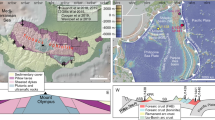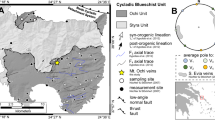Abstract
Pelitic schists of the Sanbagawa metamorphic belt contain several types of polymineralic veins that formed during the late stages of exhumation. The vein mineral assemblages are quartz + albite + K-feldspar + chlorite ± calcite (Type I, II) and quartz + albite + calcite (Type III). Type I and II veins contain quartz and albite with stretched-crystal and elongate-blocky textures, respectively. The mineral species within Type I veins vary with compositional bands within the host rocks. Type III veins are characterized by euhedral to subhedral quartz grains with concentric zoning and a homogeneous distribution along the vein length. The vein textures vary depending on the crack aperture during multiple crack-seal events: <0.08 mm for Type I, and 0.5–10 mm for Type III. Type II veins show intermediate features between Type I and III veins in terms of mineral distribution (weak dependence on the host rock composition) and apparent crack aperture (less than 1–15 mm). These observations suggest a transition in the dominant transport mechanism of vein components with increasing crack aperture, from diffusion from host rocks to fluid advection along cracks.









Similar content being viewed by others
References
Aoki K, Iizuka T, Hirata T, Maruyama S, Terabayashi M (2007) Tectonic boundary between the Sanbagawa belt and the Shimanto belt in central Shikoku, Japan. J Geol Soc Japan 113:171–183
Aoya M (2001) P-T-D path of eclogite from the Sambagawa belt deduced from combination of petrological and microstructural analyses. J Petrol 42:1225–1248
Aoya M (2003) Subduction-stage pressure path of eclogite from the Sambagawa belt: prophetic record for oceanic-ridge subduction. Geology 31:1045–1048
Banno S (1998) Pumpellyite-actinolite facies of the Sanbagawa metamorphism. J Metamorphic Geol 16:117–128
Banno S, Toriumi S, Obata M, Nishiyama T (2000) Dynamics of petrogenesis. University of Tokyo Press, Tokyo
Batkhishig B, Bignal G, Tsuchiya N (2005) Hydrothermal quartz vein formation, revealed by coupled SEM-CL imaging and fluid inclusion microthemometry: shuteen complex, south Gobi, Mongolia. Resource Geol 55:1–8
Bignall G, Sekine K, Tsuchiya N (2004) Fluid-rock interaction processes in the Te Kopia geothermal field (New Zealand) revealed by SEM-CL imaging. Geothermics 33:615–635
Bodnar JB, Vityk MO (1994) Interpretation of microthermometric data for H2O–NaCl fluid inclusions. In: DeVivo B, Frezzotti ML (ed) Fluid inclusion in minerals: methods and applications. Blacksburg, VA, Virginia Tech, pp 117–130
Bons PD (2000) The formation of veins and their microstructures. J Virtual Explorer 2
Bons PD (2001) Development of crystal morphology during unitaxial growth in a progressively widening vein: I. The numerical model. J Structural Geol 23:865–892
Cox SF, Etheridge MA (1983) Crack-seal fibre growth mechanism and their significance in the development of oriented layer silicate microstructures. Tectonophys 92:147–170
Enami M, Wallis SR, Banno Y (1994) Paragenesis of sodic pyroxene-bearing quartz schists: implications for the P–T history of the Sanbagawa belt. Contrib Mineral Petrol 116:182–198
Etheridge MA, Wall VJ, Cox SF (1984) High fluid pressures during regional metamorphism and deformation: implications for mass transport and deformation mechanism. J Geophys Res 86:4344–4358
Fisher DM, Brantley SL (1992) Models of quartz overgrowth and vein formation: deformation and episodic fluid flow in an ancient subduction zone. J Geophys Res 97:20043–20061
Fisher DM, Brantley SL, Everett M, Dzvonik J (1995) Cyclic fluid flow through a regionally extensive fracture network within the Kodiak accretionary prism. J Geophys Res 100:12881–12894
Fournier RO, Potter RW (1982) An equation correlating the solubility of quartz in water from 25° to 900°C up to 10,000 bars. Geochim Consmochim Acta 46:1969–1973
Hashimoto M, Tagiri M, Kusakabe K, Masuda K, Yano T (1992) Geologic structure formed by tectonic stacking of sliced layers in the Sanbagawa metamorphic terrain, Kodama-Nagatoro area, Kanto Mountains. J Geol Soci Japan 98:953–965 (in Japanese with English abstract)
Helgeson HC, Delany JM, Nesbitt JW, Bird DK (1978) Summary and critique of the thermodynamic properties of rock-forming minerals. Am J Sci 278:1–229
Higashino T (1990) The higher-grade metamorphic zonation of the Sanbagawa metamorphic belt, in central Shikoku Japan. J Metamorphic Geol 8:413–423
Hilgers C, Urai JL (2002) Microstructural observations on natural syntectonic fibrous veins: implication for the growth process. Tectonophys 352:257–274
Hilgers C, Koehn D, Bons PD, Urai JL (2001) Development of crystal morphology during unitaxial growth in a progressively widening vein: II. Numerical simulations of the evolution of antitaxial fibrous veins. J Structural Geol 23:873–885
Itaya T, Takasugi H (1988) Muscovite K–Ar ages of the Sanbagawa schists, Japan and argon depletion during cooling and deformation. Contrib Mineral Petrol 100:281–290
Iwamori H (2000) Thermal effects of ridge subduction and its implications for the origin of granitic batholith and paired metamorphic belts. Earth Planet Sci Let 181:131–144
Johnson JW, Oelkers EH, Helgeson HC (1992) SUPCRT92: a software package from calculating the standard molal thermodynamic properties of minerals, gases, aqueous species, and reactions from 1 to 5000 bar and 0° to 1000°C. Comput Geosci 1:899–947
Kretz R (1983) Symbols for rock forming minerals. Am Mineral 68:277–279
Lasaga AC (1997) Kinetic theory in the earth sciences. Princeton University Press, Princeton
Masago H, Okamoto K, Terabayashi M (2005) Exhumation tectonics of the Sanbagawa high-pressure metamorphic belt, southwest Japan–constraints from the upper and lower boundary faults. Int Geol Rev 47:1194–1206
Manning CE (2006) Mobilizing aluminum in crustal and mantle fluids. J Geochem Explor 89:251–253
Matsumoto K, Banno S, Hirajima T (2005) Pseudosection analysis for the Sanbagawa pelitic schist and its implication to the thermal structure of high-pressure intermediate type of metamorphism. Proc Jpn Acad Ser B 81:273–277
Meyer C (1965) An early potassic type of wall-rock alteration at Butte, Montana. Am Mineral 50:1717–1722
Miyashiro A (1961) Evolution of metamorphic belts. J Petrol 2:277–311
Miyazaki K, Okumura K (2002) Thermal modeling in shallow subduction: an application to low P/T metamorphism of the Cretaceous Shimanto Accretionary Complex, Japan. J Metamorphic Geol 20:441–452
Moriyama Y, Wallis S (2002) Three-dimensional finite strain analysis in the high-grade part of the Sanbagawa belt using deformed meta-conglomerate. Island Arc 11:111–121
Nakajima T, Banno S, Suzuki T (1977) Reactions leading to the disappearance of pumpellyite in low-grade metamorphic rocks of the Sanbagawa metamorphic belt in central Shikoku, Japan. J Petrol 18:263–284
Nishiyama T (1989) Kinetics of hydrofracturing and metamorphic veining. Geology 17:1068–1071
Okamoto A, Toriumi M (2004) Optimal mixing properties of calcic and subcalcic amphiboles: applications of Gibbs’ method to the Sanbagawa schists, SW Japan. Contrib Mineral Petrol 149:529–545
Okamoto A, Toriumi M (2005) Progress of actinolite-forming reactions in mafic schists during retrograde metamorphism: an example from the Sanbagawa metamorphic belt in central Shikoku, Japan. J Metamorphic Geol 23:335–356
Ota T, Terabayashi M, Katayama I (2004) Thermodynamic structure and metamorphic evolution of the Iratsu eclogite body in the Sanbagawa belt, central Shikoku, Japan. Lithos 73:95–126
Ramsay JG (1980) The crack-seal mechanism of rock deformation. Nature 284:135–139
Reed MH (1997) Hydrothermal alteration and its relationship to ore fluid composition. In: Barnes HL (ed) Geochemistry of hydrothermal ore deposits, 3rd edn. Wiley, New York
Rusk B, Reed M (2002) Scanning electron microscope-cathodoluminescence analysis of quartz reveals complex growth histories in veins from the Butte porphyry copper deposit, Montana. Geology 30:727–730
Sakai C, Banno S, Toriumi M, Higashino T (1985) Growth history of gartnet in pelitic schists of the Sanbagawa metamorphic terrain in central Shikoku. Lithos 18:81–95
Spandler C, Hermann J (2006) High-pressure veins in eclogite from New Caledonia and their significance for fluid migration in subduction zones. Lithos 89:135–153
Spear FS (1993) Metamorphic phase equilibria and pressure–temperature–time paths. Mineralogical Society of America, Washington, DC
Tagiri M (1981) A measurement of the graphitizing-degree by the X-ray powder diffractometer. J Jpn Assoc Min Petrol Econ Geol 76:345–352
Taira A, Okada H, Whitaker JH McD, Smith AJ (1982) The Shimanto belt of Japan: cretaceous-lower Miocene active margin sedimentation. In: Leggett JK (ed) Trench-Forearc geology: sedimentation and tectonics on modern and ancient active plate margins. Blackwell, Oxford Geological Society Special Publication 10
Takasu A (1989) P–T histories of peridotite and amphibolite tectonic blocks in the Sambagawa metamorphic belt, Japan. In: Daly JS, Cliff RA, Yardley WD (ed) The evolution of metamorphic belts. vol 43. The Geological Society, London
Takasu A, Dallmeyer RD (1990) 40Ar-39Ar mineral age constraints for the tectonothermal evolution of the Sambagawa metamorphic belt, central Shikoku, Japan: a Cretaceous accretionary prism. Tectonophys 185:111–139
Takeshita T, Hara I (1998) c-Axis fabrics and microstructures in a recrystallized quartz vein deformed under fluid-rich greenschist conditions. J Structural Geol 20:417–431
Togami S, Takano M, Kumazawa M, Mchibayashi K (2000) An algorithm for the transformation of XRF images into mineral distribution maps. Can Mineral 38:1283–1294
Toriumi M, Teruya J (1988) Tectono-metamorphism of the Shimanto belt. Modern Geol 12:303–326
Toriumi M, Hara E (1995) Crack geometries and deformation by the crack-seal mechanism in the Sambagawa metamorphic belt. Tectonophys 245:249–261
Urai JL, Williams PF, Roermund HLM (1991) Kinematics of crystal growth in syntectonic fibrous veins. J Structural Geol 7:823–836
Wallis SR, Banno S, Radvanec M (1992) Kinematics, structure and relationship to metamorphism of the east–west flow in the Sanbagawa belt, southwest Japan. Island Arc 1:176–185
Wallis SR (1998) Exhuming the Sanbagawa metamorphic belt: the importance of tectonic discontinuities. J Metamorphic Geol 16:83–95
Walther JV, Orville PM (1982) Rates of metamorphism and volatile production and transport in regional metamorphism. Contrib Mineral Petrol 79:252–257
Widmer T, Thompson AB (2001) Local origin of high pressure vein material in eclogite facies of the Zamatte-Saas zone, Switzerland. Am J Sci 301:627–656
Wiltschko DV, Morse JW (2001) Crystallization pressure versus “crack seal” as the mechanism for banded veins. Geology 29:79–82
Yardley BWD (1986) Fluid migration and veining in the Connemara Schists, Ireland. In: Walther JV, Wood BJ (ed) Fluid-rock interactions during metamorphism. Springer-Verlag
Acknowledgments
We thank T. Kuwatani for assistance in undertaking EPMA analyses, M. Toriumi and P. R. L. Browne for valuable comments on an early version of the manuscript, and K. Morohashi for help in the field. We are grateful to M. H. Reed and D. Koehn for extensive reviews of the manuscript and J. Hoefs for editorial handling. This study was supported by a grant from the Japan Society for the Promotion of Science (No. 18740317) awarded to A. Okamoto.
Author information
Authors and Affiliations
Corresponding author
Additional information
Communicated by J. Hoefs.
Rights and permissions
About this article
Cite this article
Okamoto, A., Kikuchi, T. & Tsuchiya, N. Mineral distribution within polymineralic veins in the Sanbagawa belt, Japan: implications for mass transfer during vein formation. Contrib Mineral Petrol 156, 323–336 (2008). https://doi.org/10.1007/s00410-008-0288-y
Received:
Accepted:
Published:
Issue Date:
DOI: https://doi.org/10.1007/s00410-008-0288-y




